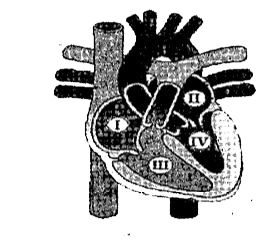Deoxygenated blood is transported from the tissues to the heart through
arteries
veins
lymph
ventricles
The correct Answer is:B
Step-by-Step Solution:
1. Understanding Blood Circulation: Blood circulates through the body in two main pathways: the systemic circulation and the pulmonary circulation. In systemic circulation, oxygenated blood is delivered to the tissues, while deoxygenated blood is returned to the heart.
2. Identifying Blood Vessels:
- Arteries: These are blood vessels that carry oxygenated blood away from the heart to the tissues. They do not transport deoxygenated blood.
- Veins: These are blood vessels that carry deoxygenated blood from the tissues back to the heart. This is the primary focus of the question.
3. Excluding Incorrect Options:
- Lymph: This is a fluid that is part of the lymphatic system and does not transport blood. Therefore, it is not the correct answer.
- Ventricles: These are chambers of the heart that pump blood but do not transport blood from the tissues to the heart. They are involved in the pumping action of the heart.
4. Conclusion: The correct answer to the question is that deoxygenated blood is transported from the tissues to the heart through veins.
Final Answer:
Deoxygenated blood is transported from the tissues to the heart through veins.
---
- Arteries: These are blood vessels that carry oxygenated blood away from the heart to the tissues. They do not transport deoxygenated blood.
- Veins: These are blood vessels that carry deoxygenated blood from the tissues back to the heart. This is the primary focus of the question.
- Lymph: This is a fluid that is part of the lymphatic system and does not transport blood. Therefore, it is not the correct answer.
- Ventricles: These are chambers of the heart that pump blood but do not transport blood from the tissues to the heart. They are involved in the pumping action of the heart.
Deoxygenated blood is transported from the tissues to the heart through veins.
Topper's Solved these Questions
- LIFE PROCESSESBOOK - BETOPPERSCHAPTER - LIFE PROCESSESEXERCISE - WORKSHEET 6
14 Videos
- LIFE PROCESSESBOOK - BETOPPERSCHAPTER - LIFE PROCESSESEXERCISE - COMPETITIVE WORKSHEET
82 Videos
- LIFE PROCESSESBOOK - BETOPPERSCHAPTER - LIFE PROCESSESEXERCISE - WORKSHEET 4
18 Videos
- HOW DO ORGANISM REPRODUCEBOOK - BETOPPERSCHAPTER - HOW DO ORGANISM REPRODUCEEXERCISE - COMPETITIVE WORKSHEET
44 Videos
- MANAGEMENT OF NATURAL RESOURCESBOOK - BETOPPERSCHAPTER - MANAGEMENT OF NATURAL RESOURCESEXERCISE - WORKSHEET 2
15 Videos
Similar Questions
Knowledge Check
Oxygenated blood is transported from the heart to the tissues through
AveinsBarteriesClymphDauriclesDeoxygenated blood is pumped by the heart in
AReptilesBBirdsCMammalsDFishes
Deoxygenated blood flows from the body into theAIBIICIIIDIV
The human circulatory system consist of the heart and blood vessels. By the pumping action of heart pure blood is transported from heart to the body parts and impure blood is collected from different body parts towards the lungs. The blood vessel that carry blood from heart to lungs is an exception to carry impure blood. Similarly, the blood vessel that carry blood from lungs to heart is also an exception to carry pure blood. Pumping action of heart is due to contraction and relaxation of the heart and its one complete cycle is called heart beat.
Which gas is dissolved in the pure blood by the lungs?
View SolutionOxygen-rich blood from the lungs comes to the thin-walled upper chamber of the heart on the left. The left upper chamber (A) then relaxes. It then contracts and the blood is allowed to enter the next chamber (B), as it expands. When the muscular left lower chamber of heart contracts the blood is pumped out to the body via aorta.
Deoxygenated blood reaches from the body to the upper chamber on the right side of heart (C) and it expands. As this part contracts, the corresponding lower chamber (D) dilates. This transfers the blood to right ventricle, which in turn pumps it to the lungs for oxygenated.
What prevents backflow of blood inside the heart during contraction?
View SolutionOxygen-rich blood from the lungs comes to the thin-walled upper chamber of the heart on the left. The left upper chamber (A) then relaxes. It then contracts and the blood is allowed to enter the next chamber (B), as it expands. When the muscular left lower chamber of heart contracts the blood is pumped out to the body via aorta.
Deoxygenated blood reaches from the body to the upper chamber on the right side of heart (C) and it expands. As this part contracts, the corresponding lower chamber (D) dilates. This transfers the blood to right ventricle, which in turn pumps it to the lungs for oxygenated.
Which chambers of human heart contain oxygenated blood?
View SolutionThe deoxygenated blood collected from the body is poured into the
View SolutionThe human circulatory system consist of the heart and blood vessels. By the pumping action of heart pure blood is transported from heart to the body parts and impure blood is collected from different body parts towards the lungs. The blood vessel that carry blood from heart to lungs is an exception to carry impure blood. Similarly, the blood vessel that carry blood from lungs to heart is also an exception to carry pure blood. Pumping action of heart is due to contraction and relaxation of the heart and its one complete cycle is called heart beat.
Impure blood and pure blood are also called as:
View Solution
